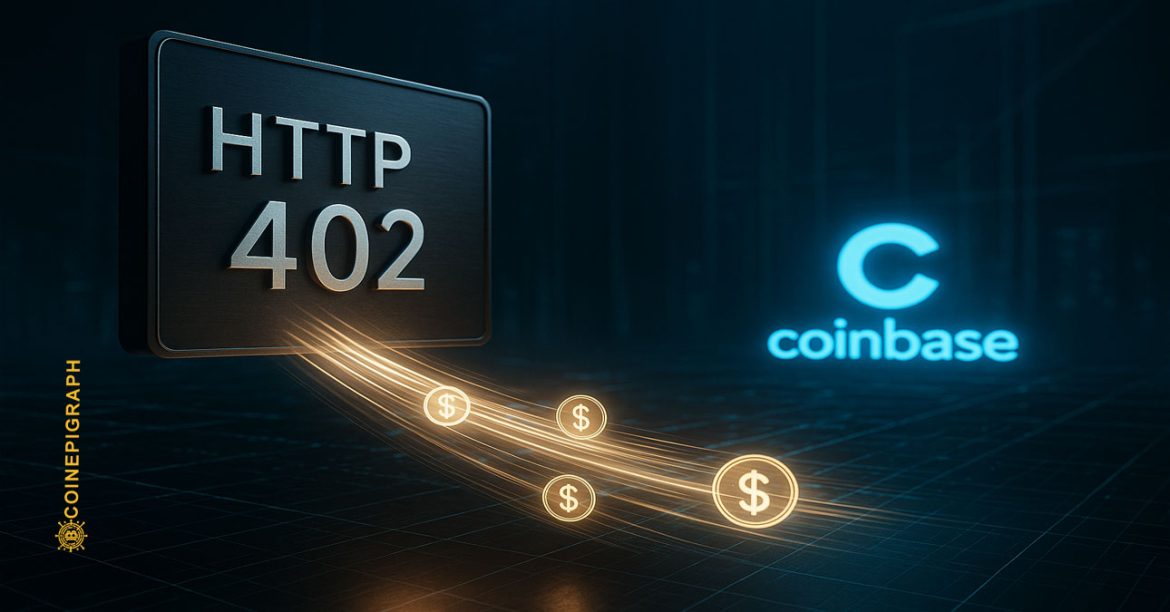By CoinEpigraph Editorial Desk | November 3, 2025
A Dormant Code Finds Its Moment
For more than three decades, the internet’s HTTP 402 status code — “Payment Required” — sat unused, a placeholder for a financial layer the web never built.
Now Coinbase has decided that moment has arrived.
The company’s newly launched x402 protocol re-activates that forgotten line of code and transforms it into a bridge between the web and stablecoin networks such as USDC. In practical terms, x402 allows a server to respond to a request with an HTTP 402 signal, prompting the client — a user, a wallet, or even an AI agent — to return a cryptographically signed on-chain payment.
The exchange describes x402 as “the missing payments standard for the internet,” and it carries a promise that could ripple far beyond crypto.
From Subscription Fatigue to Pay-Per-Action
x402 is designed to make micro-transactions native to the internet’s plumbing.
Instead of locking content or software behind monthly subscriptions, developers could charge per API call, per download, or per megabyte of data used — all handled automatically through the 402 response loop.
It’s an idea that dovetails with Coinbase’s broader push into what it calls Agentic Commerce: a world where autonomous AI agents, bots, and digital services negotiate and settle payments without human intervention.
In this emerging framework, value moves like data — frictionless, verifiable, and programmable.
Why Stablecoins Matter
At the heart of the protocol is USDC, the dollar-backed stablecoin jointly managed by Coinbase and Circle.
Because USDC maintains parity with the U.S. dollar while operating on public blockchains, it provides the stability that cryptocurrencies traditionally lack and the transparency that bank-based rails cannot match.
By embedding USDC payments directly into HTTP, Coinbase is effectively making the browser a payment endpoint.
Partners including Circle, NEAR Protocol, and AWS have signaled support, and the full technical specification is openly published at x402.org.
Elegant Engineering, Expansive Implications
Technically, x402 works through standard web headers — no proprietary plug-ins or new protocols required.
Any service that understands HTTP can integrate payments with minimal friction.
If adoption grows, the outcome could be profound:
- API economies rebuilt around pay-as-you-go access.
- Reduced reliance on legacy card networks and payment processors.
- Increased demand for Ethereum and Base network capacity as on-chain settlements scale.
Research firm 21Shares described x402 as “a stealth catalyst for Ethereum demand,” positioning it as the first credible path toward a truly value-aware web.
Obstacles on the Road to Standardization
Coinbase will need more than code to turn x402 into an industry norm.
Wallet providers must implement the 402 payment handshake safely; merchants and developers must trust automated transfers; regulators will inevitably question machine-initiated transactions that bypass conventional KYC layers.
Yet the strategic direction is unmistakable. As global commerce leans toward programmable money and tokenized settlement, x402 offers a glimpse of how those systems could merge with the fabric of the web itself.
Strategic Positioning
For Coinbase, x402 strengthens multiple fronts:
- It expands the utility of Base, the company’s Layer-2 network.
- It reinforces USDC as the de facto medium of digital settlement.
- It positions Coinbase not just as an exchange but as critical internet infrastructure — the financial layer beneath Web3.
If the standard gains traction, Coinbase’s role could shift from market participant to protocol steward, influencing how online value flows much as Visa once shaped card payments.
HTTP 402 Lives Again
The revival of a single status code may sound trivial, but it represents a philosophical turning point.
If HTTP 401 defined identity (authentication) and HTTPS defined trust (security), then HTTP 402, reborn through x402, may come to define value.
Coinbase’s move reimagines the internet as it might have been built — one where content, code, and currency share the same bandwidth.
At Coinepigraph, we pride ourselves on delivering cryptocurrency news with the utmost journalistic integrity and professionalism. Our dedicated team is committed to providing accurate, insightful, and unbiased reporting to keep you informed in the ever-evolving crypto landscape. Stay tuned as we expand our coverage to include new sections and thought-provoking op-eds, ensuring Coinepigraph remains your trusted source for all things crypto. -Ian Mayzberg Editor-in-Chief
The team at CoinEpigraph.com is committed to independent analysis and a clear view of the evolving digital asset order.
To help sustain our work and editorial independence, we would appreciate your support of any amount of Bitcoin/Satoshi to this address below: 3NM7AAdxxaJ7jUhZ2nyfgcheWkrquvCzRm
and through our Support Page.
🔍 Disclaimer: CoinEpigraph is for entertainment and information, not investment advice. Markets are volatile — always conduct your own research.
COINEPIGRAPH does not offer investment advice. Always conduct thorough research before making any market decisions regarding cryptocurrency or other asset classes. Past performance is not a reliable indicator of future outcomes. All rights reserved 2024-2025.





